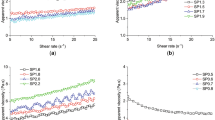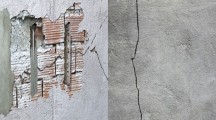Abstract
The objective of the present paper is to show an experimental method allowing the characterisation of Biot's hydro-mechanical coupling coefficient for cement mortar. This coefficient results from the mathematical formulation of a thermo-hygro-mechanical coupling model for non-saturated media [3, 8, 9, 11]. In the literature, the expression of Biot's coefficient is based on an empirical formula. The proposed method of its identification is bosed on two experiments: the dimensional variation tests and the characterisation of the elastic properties as a function of different relative humidity. We deduce Biot's coefficient by using the thermal-porous-elastic behaviour law of Coussy [2, 3].
In the literature, liquid Biot's coefficientb l is often approached with the degree of liquid, saturationS l . By comparing the results of liquid Biot's coefficientb l determined experimentally and the coefficient of liquid saturationS l , we show a good agreement between the two coefficients for small to moderate relative humidity. For important relative humidity (i.e. higher than 70%), the value of liquid Biot's coefficient is slightly lower than saturation.
Résumé
L'objectif de ce papier consiste à montrer une méthode expérimentale permettant la caractérisation du coefficient de couplage hydromécanique de Biot pour le mortier de ciment. Ce coefficient résulte de la formulation mathématique d'un modèle de couplage thermo-hygro-méchanique pour les milieux poreux non-saturés [3, 8, 9, 11]. Dans la littérature, l'expression du coefficient de Biot est basée sur deux expériences: l'essai de variation dimensionnelle et de caractérisation des propriétés élastiques à différentes humidités relatives. Nous déduisons ainsi le coefficient de Biot en se servant de la loi de comportement thermo-poro-élastique de Coussy [2, 3].
Dans la littérature, le coefficient de Biot liquide bl est souvent rapproché avec le degré de la saturation liquide Sl. En comparant les résultats de ces deux coefficients, nous montrons une bonne concordance entre eux pour des humidités relatives faibles et moyennes. Par contre, pour des humidités relatives importantes (c'est-à-dire supérieures à 70%), nous trouvons que le coefficient de Biot liquide est légèrement inférieur au degré de la saturation.
Similar content being viewed by others
References
Bourbie, T., Coussy, O. and Zinszner, B., ‘Acoustique des milieux poreux’, (Édiditions Technip, Paris, 1986).
Coussy, O., ‘Mechanics of porous continua’, (John Wiley & Sons, 1995).
Coussy, O., ‘Mécanique des milieux poreus’, (Editions Technip, Paris, 1991).
Duforestel, T. and Miquel, A., ‘Advanced hygrometric measurements’, in ‘International Workshop on Mass-Energy Transfer and Deterioration of Building Components’, January (Paris, 1995).
Miquel, A., ‘Détermination expérimentale des caractéristiques hydriques des matériaux du bâtiment: Contribution à la mise au point et validation de techniques nouvelles’, PhD thesis, (Université Paris XII-Val-de-Marne, 1996).
Monajed, G., ‘Prévention des désordres: Maîtriser le trio infernal: eau, chaleur et contraintes mécaniques’, in ‘Lettre d'information CSTB Recherche’, No40-(Paris, 1999).
Mounajed, G. and Obeid, W., ‘Thermo-hygro-mechanical coupling of saturated and non-saturated porous media—Modelling by using Finite Element method’, in ‘Workshop on modelling of deterioration in composite building components due to heat and mass transfer’, (BRI-Tsukuba, 22nd–23rd January, 1998).
Lassabatère, T., ‘Couplages hydromécaniques en milieu poreux non saturé avec changement de phase—Application au retrait de dessiccation’, PhD thesis, Étole Nationale des Ponts et Chaussées, Paris, 1994) 129–144.
Obeid, W., Mounajed, G. and Alliche, A., ‘Mathematical formulation of thermo-hygro-mechanical coupling problems in nonsaturated porous media’,Comput. Methods in Applied Mech. Eng. 190 (39) (2001) 5105–5122.
Obeid, W., Alliche, A. and Mounajed G., ‘Identification of the physical parameters used in the thermo-hygro-mechanical model: Application to the case of cement mortar’,Transport in Prorous Media, (Accepted in 2001).
Obeid, W., ‘Modélisation du couplage thermo-hygromécanique en milieux poreux non saturés’, Ph.D. Thesis, École Nationale des Ponts et Chaussés (1998).
Obeid, W. and Mounajed, G., ‘Modelling of building materials subject to thermal-hygro-mecanical couplings’, in ‘Second LAAS International Conference on Computer Simulation’, (Faculty of Engineering and Architecture American University of Beirut, Lebanon, 1997) 573–579.
Obeid, W., Mounajed, G. and Alliche, A., ‘Étude du couplage thermo-hygro-mécanique en milieux poreux non saturés’ in ‘Cahiers du CSTB’ no 3200, (Paris, 2000).
RILEM, Concrete test methods,Mater. Struct. 12 (69) (1979) 221–242.
Schrefler, B.A., ‘Finite element in environmental engineering: Coupled thermo-hydro-mechanical processes in porous media including pollutant transport’, Archives of Computational Methods in Engineering, Vol. 2, 3, 1-1. © 1995 by CIMNE, Barcelona (Spain, 1995).
Schrefler, B. A. and Zhan, X. Y., ‘A fully-coupled model for water flow and airflow in deformable porous media’,Water Resources Research,29 (1) (1993) 155–167.
SYMPHONIE, ‘A general Finite Element Software dealing with T-H-M problem coupling’ developed by Dr. G. Mounajed in CSTB (Paris, 1994).
Torrenti, J. M., ‘Comportement multiaxial du béton: Aspects expérimentaux et modélisation’, PhD Thesis École Nationale des Ponts et Chaussées, (1987).
Wittmann, F. H., ‘Deformation of concrete at variable moisture content’, in ‘Mechanics of Geomaterials’, Edited by Z. Bažant © 1985 (John Wiley & Sons Ltd, 1985).
Author information
Authors and Affiliations
Additional information
Editorial Note CSTB is a RILEM Titular Member.
Rights and permissions
About this article
Cite this article
Obeid, W., Mounajed, G. & Alliche, A. Experimental identification of Biot's hydro-mechanical coupling coefficient for cement mortar. Mat. Struct. 35, 229–236 (2002). https://doi.org/10.1007/BF02533084
Received:
Accepted:
Issue Date:
DOI: https://doi.org/10.1007/BF02533084




